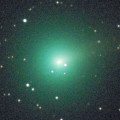
|
Now it is 8.2 mag (Jan. 21, Michael Jager). It will fade out rapidly after this. It stays observable in good condition.
Date(TT) R.A. (2000) Decl. Delta r Elong. m1 Best Time(A, h)
Jan. 27 12 29.09 10 10.0 0.501 1.324 122 7.7 4:07 ( 0, 65)
Feb. 3 12 36.82 9 52.6 0.501 1.351 127 7.9 3:47 ( 0, 65)
|

|
Now it is 10.2 mag (Jan. 19, Osamu Miyazaki). It will fade out rapidly after this. It stays observable in good condition. It is fainter than this ephemeris recently.
Date(TT) R.A. (2000) Decl. Delta r Elong. m1 Best Time(A, h)
Jan. 27 3 56.37 15 19.8 0.672 1.399 113 8.7 19:33 ( 0, 70)
Feb. 3 4 14.59 15 49.5 0.703 1.402 111 8.5 19:24 ( 0, 71)
|

|
It returns for the first time in 70 years. It will brighten up to 4.5 mag in spring. It suddenly brightened in major outburst by 5 mag up to 11.5 mag on July 20 (E. Tamas, Francois Kugel). It brightened again in another major outburst up to 9.4 mag on Nov. 15 (Nick James). Now it is 8.0 mag (Jan. 21, Michael Jager). It will brighten rapidly after this. In the Northern Hemisphere, it will be unobservable in April. In the Southern Hemisphere, it is not observable now, but it will appear in April.
Date(TT) R.A. (2000) Decl. Delta r Elong. m1 Best Time(A, h)
Jan. 27 21 2.51 38 13.5 1.969 1.659 57 8.9 18:50 (124, 19)
Feb. 3 21 30.75 38 15.8 1.898 1.566 55 8.9 18:56 (125, 18)
|

|
Now it is 9.8 mag (Jan. 23, Taras Prystavski). Fading slowly. In the Northern Hemisphere, it will be getting higher gradually.
Date(TT) R.A. (2000) Decl. Delta r Elong. m1 Best Time(A, h)
Jan. 27 16 23.00 -28 58.1 1.588 1.349 57 9.5 5:35 (327, 17)
Feb. 3 16 46.71 -25 16.5 1.518 1.332 59 9.4 5:31 (325, 20)
|
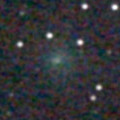
|
Now it is 13.3 mag (Dec. 16, Michael Mattiazzo). It will fade out rapidly after this. It will be fainter than 18 mag in April. Now it is not observable. It will appear in February.
Date(TT) R.A. (2000) Decl. Delta r Elong. m1 Best Time(A, h)
Jan. 27 20 28.69 -35 51.2 1.730 0.841 17 11.4 5:35 (297,-25)
Feb. 3 20 18.22 -34 57.9 1.721 0.872 20 11.9 5:31 (300,-19)
|

|
Now it is 12.2 mag (Jan. 21, Osamu Miyazaki). It stays 13 mag for a while. In the Northern Hemisphere, it stays observable in good condition.
Date(TT) R.A. (2000) Decl. Delta r Elong. m1 Best Time(A, h)
Jan. 27 8 30.17 18 53.2 3.217 4.201 179 12.5 0:10 ( 0, 74)
Feb. 3 8 17.88 20 33.2 3.201 4.172 168 12.5 23:25 ( 0, 76)
|

|
It approached to Earth down to 0.38 a.u., and brightened up to 8.0 mag in autumn (Sept. 29, Virgilio Gonano). Now it is 13.5 mag (Jan. 15, Toshihiko Ikemura, Hirohisa Sato). It will fade out rapidly after this. It will be fainter than 18 mag in May. It stays observable in good condition.
Date(TT) R.A. (2000) Decl. Delta r Elong. m1 Best Time(A, h)
Jan. 27 8 15.99 -11 20.6 0.807 1.730 149 12.8 23:50 ( 0, 44)
Feb. 3 8 9.28 -9 41.2 0.868 1.792 150 13.2 23:16 ( 0, 45)
|

|
It was observed at 9-10 mag for a long time in 2023. Now it is 13.8 mag (Jan. 18, ATLAS South Africa). Fading slowly. In the Northern Hemisphere, it will never be observable after this. It locates somewhat low in the Southern Hemisphere. But it will become high in spring.
Date(TT) R.A. (2000) Decl. Delta r Elong. m1 Best Time(A, h)
Jan. 27 23 25.04 -40 3.0 4.306 3.639 42 12.8 18:50 ( 40, -1)
Feb. 3 23 28.52 -39 48.4 4.409 3.695 38 12.9 18:56 ( 44, -5)
|

|
It brightened up to 8 mag from 2022 summer to 2023 spring. Now it is 13.0 mag (Jan. 21, Chris Wyatt). Fading slowly. In the Northern Hemisphere, it will be getting lower gradually after this, and it will be unobservable in May. In the Southern Hemisphere, it stays observable in good condition.
Date(TT) R.A. (2000) Decl. Delta r Elong. m1 Best Time(A, h)
Jan. 27 5 16.36 0 56.2 4.170 4.843 128 13.1 20:52 ( 0, 56)
Feb. 3 5 12.66 2 0.1 4.316 4.904 121 13.2 20:21 ( 0, 57)
|
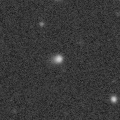
|
It will approach to Sun down to 0.4 a.u. in late September, and it is expected to brighten up to 0 mag. Now it is 13.5 mag (Jan. 21, Michael Jager). It will brighten rapidly after this. It stays observable in good condition. At the high light, in the Northern Hemisphere, it will be observable in good condition after the perihelion passage. In the Southern Hemisphere, it will be observable in the low sky before and after the perihelion passage.
Date(TT) R.A. (2000) Decl. Delta r Elong. m1 Best Time(A, h)
Jan. 27 15 9.80 -7 52.4 4.017 3.952 79 13.5 5:35 (335, 44)
Feb. 3 15 10.79 -7 53.9 3.814 3.870 85 13.3 5:31 (342, 45)
|

|
Now it is 15.1 mag (Jan. 23, Ken-ichi Kadota). It will fade out rapidly after this. It will be fainter than 18 mag in February. It locates somewhat low.
Date(TT) R.A. (2000) Decl. Delta r Elong. m1 Best Time(A, h)
Jan. 27 18 16.05 -15 7.1 1.857 1.165 33 13.4 5:35 (297, 11)
Feb. 3 18 41.91 -13 24.8 1.881 1.201 34 14.1 5:31 (296, 12)
|

|
Now it is 14.2 mag (Jan. 16, Ken-ichi Kadota). It stays 13 mag for a while. It locates somewhat low in the Northern Hemisphere. In the Southern Hemisphere, it stays observable in good condition. It is expected to brighten up to 12.5 mag in spring. At the high light, it will be observable in excellent condition in the Southern Hemisphere, but it will be low in the Northern Hemisphere.
Date(TT) R.A. (2000) Decl. Delta r Elong. m1 Best Time(A, h)
Jan. 27 15 28.30 -23 13.6 2.896 2.734 70 13.6 5:35 (336, 28)
Feb. 3 15 24.48 -24 55.4 2.746 2.722 78 13.5 5:31 (343, 28)
|

|
Now it is 12.5 mag (Jan. 21, Chris Wyatt). It stays observable in good condition.
Date(TT) R.A. (2000) Decl. Delta r Elong. m1 Best Time(A, h)
Jan. 27 8 22.75 21 11.4 5.190 6.173 176 13.5 0:02 ( 0, 76)
Feb. 3 8 19.26 21 17.4 5.206 6.175 168 13.5 23:27 ( 0, 76)
|
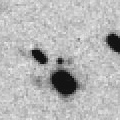
|
It will approach to Earth down to 0.2 a.u. from February to March, and it is expected to brighten up to 13 mag. Now it is 14.6 mag (Jan. 24, ATLAS Chile). It will fade out rapidly after this. It will be fainter than 18 mag in May. It stays observable in good condition.
Date(TT) R.A. (2000) Decl. Delta r Elong. m1 Best Time(A, h)
Jan. 27 1 37.73 -15 57.6 0.405 0.941 71 13.8 18:50 ( 28, 34)
Feb. 3 2 5.72 -16 30.0 0.360 0.939 71 13.5 18:56 ( 29, 33)
|

|
Now it is 13.7 mag (Jan. 21, Chris Wyatt). Fading slowly. In the Northern Hemisphere, it will be unobservable in May. In the Southern Hemisphere, it stays observable in good condition.
Date(TT) R.A. (2000) Decl. Delta r Elong. m1 Best Time(A, h)
Jan. 27 9 17.30 -45 32.5 4.005 4.510 114 13.6 0:57 ( 0, 9)
Feb. 3 9 2.57 -45 50.2 4.009 4.546 117 13.7 0:14 ( 0, 9)
|

|
First return of a new periodic comet which brightened up to 10 mag in 2001. It is expected to brighten up to 12-13 mag from February to March. Now it is 16.4 mag (Jan. 11, Toshihiko Ikemura, Hirohisa Sato). It will turn to fade out rapidly after brightening. In the Northern Hemisphere, it will be getting lower gradually. But it will be getting higher again after April. In the Southern Hemisphere, it will never be observable after this. Thomas Lehmann reported it was bright as 13.7 mag on Jan. 9.
Date(TT) R.A. (2000) Decl. Delta r Elong. m1 Best Time(A, h)
Jan. 27 23 35.53 11 32.3 1.804 1.461 53 14.4 18:50 ( 79, 36)
Feb. 3 23 43.56 15 34.4 1.835 1.439 51 13.7 18:56 ( 87, 33)
|

|
It brightened up to 7.8 mag in late July (July 20, Thomas Lehmann). Now it is 14.4 mag (Jan. 14, Giuseppe Pappa). Fading slowly. It stays observable in good condition.
Date(TT) R.A. (2000) Decl. Delta r Elong. m1 Best Time(A, h)
Jan. 27 15 7.88 -0 53.6 2.746 2.781 81 14.1 5:35 (331, 50)
Feb. 3 15 2.72 0 44.6 2.670 2.851 90 14.2 5:31 (342, 54)
|

|
Now it is 14.5 mag (Jan. 24, ATLAS Chile). It stays 14 mag for a while. It stays extremely low in the Northern Hemisphere. In the Southern Hemisphere, it stays observable in good condition.
Date(TT) R.A. (2000) Decl. Delta r Elong. m1 Best Time(A, h)
Jan. 27 12 14.53 -38 34.5 4.967 5.276 102 14.2 3:53 ( 0, 16)
Feb. 3 12 14.89 -38 47.1 4.861 5.259 108 14.1 3:26 ( 0, 16)
|

|
It brightened up to 8.3 mag in 2021-2022 winter (Jan. 6, 2022, Toshiyuki Takahashi). Now it is 15.0 mag (Jan. 11, ATLAS Chile). It stays 15 mag for a while. It stays extremely low in the Northern Hemisphere. In the Southern Hemisphere, it stays observable in good condition.
Date(TT) R.A. (2000) Decl. Delta r Elong. m1 Best Time(A, h)
Jan. 27 11 23.19 -52 23.1 6.960 7.197 100 14.3 3:02 ( 0, 3)
Feb. 3 11 20.23 -52 56.9 6.937 7.242 104 14.3 2:31 ( 0, 2)
|
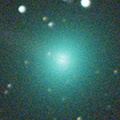
|
It approached to Earth down to 0.2 a.u. in early November, and brightened up to 6.2 mag (Nov. 11, Marco Goiato). Now it is 13.2 mag (Jan. 3, Chris Wyatt). Fading rapidly. In the Northern Hemisphere, it will never be observable after this. It locates somewhat low in the Southern Hemisphere.
Date(TT) R.A. (2000) Decl. Delta r Elong. m1 Best Time(A, h)
Jan. 27 23 41.57 -43 11.3 2.279 1.749 46 14.5 18:50 ( 36, -2)
Feb. 3 23 50.42 -43 20.4 2.412 1.838 44 14.8 18:56 ( 39, -5)
|

|
It returned for the first time in 68 years. It will brighten up to 7.5 mag in summer. Now it is 14.5 mag (Jan. 19, Thomas Lehmann). It will brighten rapidly after this. In the Northern Hemisphere, it will be getting lower gradually. In the Southern Hemisphere, it will be getting lower gradually after this, and it will be unobservable in April. At the high light, it locates low in the Northern Hemisphere, or it is not observable in the Southern Hemisphere.
Date(TT) R.A. (2000) Decl. Delta r Elong. m1 Best Time(A, h)
Jan. 27 2 51.81 -7 35.3 2.211 2.447 91 14.8 18:50 ( 8, 47)
Feb. 3 2 52.02 -5 15.7 2.231 2.373 85 14.5 18:56 ( 21, 48)
|
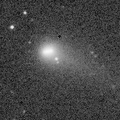
|
Now it is 14.0 mag (Jan. 16, Hiroshi Abe). It stays 15 mag for a while. In the Northern Hemisphere, it stays observable in good condition. It locates somewhat low in the Southern Hemisphere.
Date(TT) R.A. (2000) Decl. Delta r Elong. m1 Best Time(A, h)
Jan. 27 2 56.34 21 11.9 1.731 2.157 101 14.7 18:50 ( 16, 76)
Feb. 3 3 3.68 22 2.8 1.789 2.136 96 14.7 18:56 ( 39, 74)
|

|
It brightened up to 12.1 mag in 2023 spring (May 20, Jose Guilherme de S. Aguiar). Now it is 14.8 mag (Jan. 21, Chris Wyatt). Fading slowly. In the Northern Hemisphere, it is not observable now. In the Southern Hemisphere, it stays observable in good condition.
Date(TT) R.A. (2000) Decl. Delta r Elong. m1 Best Time(A, h)
Jan. 27 3 45.58 -74 36.6 4.084 3.972 76 15.0 19:20 ( 0,-19)
Feb. 3 3 47.78 -72 6.7 4.111 4.013 77 15.0 18:56 ( 0,-17)
|
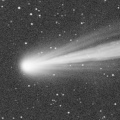
|
It approached to Sun down to 0.23 a.u. and brightened up to 2.5 mag in mid September (Sept. 18, Juan Jose Gonzalez). Now it is 16.4 mag (Jan. 19, Hidetaka Sato). It will fade out rapidly after this. It will be fainter than 18 mag in May. In the Northern Hemisphere, it is not observable now, but it will appear in February. In the Southern Hemisphere, it stays observable in good condition.
Date(TT) R.A. (2000) Decl. Delta r Elong. m1 Best Time(A, h)
Jan. 27 10 47.37 -57 28.8 2.282 2.622 98 15.0 2:27 ( 0, -3)
Feb. 3 10 20.47 -57 25.6 2.308 2.720 104 15.2 1:33 ( 0, -3)
|
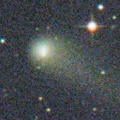
|
It brightened up to 11.1 mag in early 2022 (Mar. 31, 2022, F. Kugel, J.-G. Bosch, J. Nicolas). Now it is 15.1 mag (Jan. 20, Thomas Lehmann). It stays 16 mag for a while. In the Northern Hemisphere, it stays observable in good condition. In the Southern Hemisphere, it is not observable now, but it will appear in February.
Date(TT) R.A. (2000) Decl. Delta r Elong. m1 Best Time(A, h)
Jan. 27 17 20.93 18 46.3 6.807 6.379 60 15.4 5:35 (276, 42)
Feb. 3 17 25.52 19 26.4 6.779 6.418 64 15.4 5:31 (279, 47)
|

|
Now it is 15.4 mag (Jan. 15, Toshihiko Ikemura, Hirohisa Sato). It will fade out rapidly after this. It will be fainter than 18 mag in April. In the Northern Hemisphere, it will be getting lower gradually. In the Southern Hemisphere, it will be unobservable in March.
Date(TT) R.A. (2000) Decl. Delta r Elong. m1 Best Time(A, h)
Jan. 27 1 17.03 5 44.6 1.804 1.797 73 15.8 18:50 ( 49, 51)
Feb. 3 1 26.34 9 16.2 1.889 1.809 70 15.9 18:56 ( 60, 49)
|

|
Now it is 15.6 mag (Jan. 11, Toshihiko Ikemura, Hirohisa Sato). It stays 16 mag for a while. In the Northern Hemisphere, it will be getting lower gradually after this, and it will be unobservable in May. In the Southern Hemisphere, it stays observable in good condition.
Date(TT) R.A. (2000) Decl. Delta r Elong. m1 Best Time(A, h)
Jan. 27 4 29.00 -9 42.8 6.497 6.943 113 15.8 20:05 ( 0, 45)
Feb. 3 4 28.51 -9 3.9 6.555 6.914 107 15.8 19:37 ( 0, 46)
|
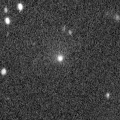
|
Very large comet. It is expected to brighten up to 13 mag in 2031. Now it is 15.9 mag (Jan. 1, Thomas Lehmann). It stays 16 mag for a while. In the Northern Hemisphere, it is not observable now. In the Southern Hemisphere, it stays observable in good condition. In the Northern Hemisphere, it is not observable until 2030.
Date(TT) R.A. (2000) Decl. Delta r Elong. m1 Best Time(A, h)
Jan. 27 2 51.88 -64 25.3 16.985 16.758 75 15.9 18:50 ( 2, -9)
Feb. 3 2 52.07 -64 6.7 16.983 16.734 73 15.9 18:56 ( 6,-10)
|
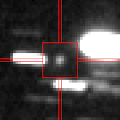
|
It is expected to brighten up to 12.5 mag in summer. Now it is 17.1 mag (Dec. 20, E. Cortes). Brightening gradually. In the Northern Hemisphere, it is not observable now. In the Southern Hemisphere, it stays observable in good condition. Around the high light, it is observable in good condition in the Southern Hemisphere, but it locates very low in the Northern Hemisphere.
Date(TT) R.A. (2000) Decl. Delta r Elong. m1 Best Time(A, h)
Jan. 27 15 2.21 -63 43.0 4.136 3.914 70 16.0 5:35 (353,-10)
Feb. 3 15 15.10 -64 57.8 4.022 3.860 73 15.9 5:31 (354,-11)
|
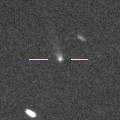
|
Now it is 16.0 mag (Jan. 1, Ken-ichi Kadota). It stays 16 mag for a while. In the Northern Hemisphere, it will be unobservable in March. In the Southern Hemisphere, it will be getting lower gradually. But it will be getting higher again after May. The brightness evolution is slower than originally expected.
Date(TT) R.A. (2000) Decl. Delta r Elong. m1 Best Time(A, h)
Jan. 27 1 40.18 -30 37.4 3.496 3.279 69 16.1 18:50 ( 21, 21)
Feb. 3 1 41.16 -30 39.9 3.548 3.243 64 16.1 18:56 ( 28, 18)
|
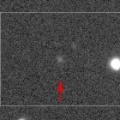
|
It will be observable at 15-16 mag from 2024 to 2025. Now it is 17.3 mag (Jan. 24, ATLAS South Africa). It stays 16 mag for a while. It stays observable in good condition.
Date(TT) R.A. (2000) Decl. Delta r Elong. m1 Best Time(A, h)
Jan. 27 13 17.27 1 31.9 3.272 3.707 108 16.3 4:56 ( 0, 56)
Feb. 3 13 18.76 1 34.9 3.160 3.692 115 16.2 4:29 ( 0, 56)
|
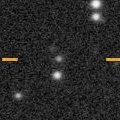
|
Now it is 16.4 mag (Jan. 23, ATLAS South Africa). Fading slowly. It will be fainter than 18 mag in May. It stays observable in good condition.
Date(TT) R.A. (2000) Decl. Delta r Elong. m1 Best Time(A, h)
Jan. 27 9 1.69 -10 9.3 0.881 1.804 150 16.4 0:41 ( 0, 45)
Feb. 3 8 56.03 -12 5.2 0.862 1.789 151 16.3 0:08 ( 0, 43)
|

|
First return of a new periodic comet which was discovered in 2011, half a year after the perihelion passage. It is expected to brighten up to 14.5 mag in spring. Now it is 16.3 mag (Jan. 14, ATLAS-MLO, Mauna Loa). Brightening slowly. It stays observable in good condition.
Date(TT) R.A. (2000) Decl. Delta r Elong. m1 Best Time(A, h)
Jan. 27 8 27.48 12 44.0 0.818 1.799 173 16.6 0:07 ( 0, 68)
Feb. 3 8 17.66 11 5.2 0.764 1.740 167 16.3 23:25 ( 0, 66)
|

|
It brightened up to 13 mag in early 2023. It stays 17 mag for a while. It stays extremely low in the Northern Hemisphere. In the Southern Hemisphere, it stays observable in good condition.
Date(TT) R.A. (2000) Decl. Delta r Elong. m1 Best Time(A, h)
Jan. 27 16 21.09 -48 9.4 4.089 3.671 58 16.4 5:35 (337, 1)
Feb. 3 16 26.42 -48 5.5 4.061 3.731 63 16.4 5:31 (340, 2)
|

|
Now it is 16.0 mag (Jan. 5, Ken-ichi Kadota). Fading gradually. It will be fainter than 18 mag in April. In the Northern Hemisphere, it will be getting lower gradually. In the Southern Hemisphere, it will be unobservable in March.
Date(TT) R.A. (2000) Decl. Delta r Elong. m1 Best Time(A, h)
Jan. 27 0 28.07 7 24.5 2.408 2.152 63 16.4 18:50 ( 64, 43)
Feb. 3 0 42.03 8 41.8 2.484 2.164 59 16.5 18:56 ( 70, 41)
|

|
It is expected to brighten up to 13 mag in early summer. Now it is 16.0 mag (Jan. 17, Ken-ichi Kadota). Brightening gradually. It locates somewhat low in the Northern Hemisphere. In the Southern Hemisphere, it will be getting lower gradually after this, and it will be unobservable in April. At the high light, it is not observable in the Southern Hemisphere, or it locates low in the Northern Hemisphere.
Date(TT) R.A. (2000) Decl. Delta r Elong. m1 Best Time(A, h)
Jan. 27 2 1.15 -23 38.0 2.208 2.177 75 16.6 18:50 ( 19, 29)
Feb. 3 2 1.62 -19 56.8 2.213 2.097 70 16.4 18:56 ( 29, 30)
|
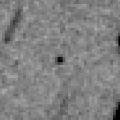
|
Now it is 15.7 mag (Jan. 21, ATLAS-HKO, Haleakala). Fading slowly. It will be fainter than 18 mag in May. In the Northern Hemisphere, it stays observable in good condition. It locates somewhat low in the Southern Hemisphere.
Date(TT) R.A. (2000) Decl. Delta r Elong. m1 Best Time(A, h)
Jan. 27 7 27.67 39 23.4 0.729 1.673 154 16.5 23:03 (180, 86)
Feb. 3 7 25.24 39 19.1 0.733 1.658 149 16.5 22:33 (180, 86)
|
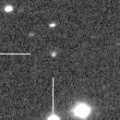
|
Now it is 16.9 mag (Jan. 20, ATLAS Chile). It stays 16 mag for a while. It locates somewhat low in the Northern Hemisphere. But it will become high in summer. In the Southern Hemisphere, it stays observable in good condition.
Date(TT) R.A. (2000) Decl. Delta r Elong. m1 Best Time(A, h)
Jan. 27 13 52.12 -27 36.4 3.302 3.450 90 16.7 5:30 ( 0, 27)
Feb. 3 13 57.89 -28 2.8 3.205 3.447 95 16.6 5:09 ( 0, 27)
|
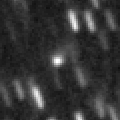
|
It stays 16 mag in the Southern sky for a long time from 2024 to 2025. It stays 16 mag for a while. It stays extremely low in the Northern Hemisphere. In the Southern Hemisphere, it stays observable in good condition.
Date(TT) R.A. (2000) Decl. Delta r Elong. m1 Best Time(A, h)
Jan. 27 16 54.70 -44 1.3 6.446 5.892 52 16.7 5:35 (330, 1)
Feb. 3 16 55.36 -44 37.8 6.324 5.868 58 16.7 5:31 (333, 3)
|

|
Now it is 17.0 mag (Jan. 9, Toshihiko Ikemura, Hirohisa Sato). It stays 17 mag for a while. In the Northern Hemisphere, it stays observable in good condition. It locates somewhat low in the Southern Hemisphere. But it will become high in autumn.
Date(TT) R.A. (2000) Decl. Delta r Elong. m1 Best Time(A, h)
Jan. 27 4 34.04 31 6.1 4.408 5.035 124 16.8 20:10 ( 0, 86)
Feb. 3 4 34.22 30 24.1 4.484 5.019 117 16.8 19:43 ( 0, 85)
|
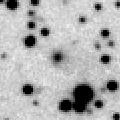
|
Now it is 16.7 mag (Jan. 8, ATLAS-MLO, Mauna Loa). It stays 17 mag for a while. In the Northern Hemisphere, it stays observable in good condition. In the Southern Hemisphere, it will be unobservable in April.
Date(TT) R.A. (2000) Decl. Delta r Elong. m1 Best Time(A, h)
Jan. 27 4 31.73 40 41.2 6.089 6.691 124 16.8 20:08 (180, 84)
Feb. 3 4 31.80 40 27.4 6.179 6.693 117 16.8 19:41 (180, 85)
|
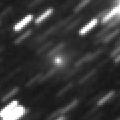
|
Very far object. Now it is 16.8 mag (Jan. 7, ATLAS Chile). It stays 17 mag for a while. In the Northern Hemisphere, it is not observable now. In the Southern Hemisphere, it stays observable in good condition.
Date(TT) R.A. (2000) Decl. Delta r Elong. m1 Best Time(A, h)
Jan. 27 2 15.55 -71 45.7 10.602 10.320 70 16.8 18:50 ( 5,-17)
Feb. 3 2 13.33 -70 55.0 10.616 10.322 70 16.8 18:56 ( 8,-17)
|

|
It is expected to brighten up to 15.5 mag from March to April. Now it is 17.3 mag (Jan. 23, E. Cortes). Brightening slowly. It locates somewhat low in the Northern Hemisphere. But it will become high in spring. In the Southern Hemisphere, it will be getting higher gradually.
Date(TT) R.A. (2000) Decl. Delta r Elong. m1 Best Time(A, h)
Jan. 27 16 27.14 -14 5.0 1.837 1.578 59 17.4 5:35 (317, 29)
Feb. 3 16 49.26 -14 24.0 1.783 1.562 60 17.0 5:31 (318, 29)
|
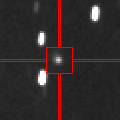
|
Now it is 16.9 mag (Jan. 19, ATLAS Chile). It stays 17 mag for a while. In the Northern Hemisphere, it will be unobservable in April. In the Southern Hemisphere, it stays observable in good condition.
Date(TT) R.A. (2000) Decl. Delta r Elong. m1 Best Time(A, h)
Jan. 27 4 46.34 -38 8.2 7.338 7.603 101 17.0 20:22 ( 0, 17)
Feb. 3 4 45.79 -37 23.3 7.366 7.581 98 17.0 19:54 ( 0, 18)
|
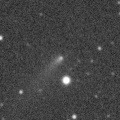
|
It brightened very rapidly up to 14.9 mag in early summer (July 13, Taras Prystavski). Now it is 17.2 mag (Jan. 16, Ken-ichi Kadota). Fading gradually. It will be fainter than 18 mag in April. In the Northern Hemisphere, it stays observable in good condition.
Date(TT) R.A. (2000) Decl. Delta r Elong. m1 Best Time(A, h)
Jan. 27 15 1.86 6 54.3 2.511 2.628 85 17.0 5:35 (328, 58)
Feb. 3 14 58.39 10 1.4 2.423 2.678 93 17.1 5:31 (339, 63)
|
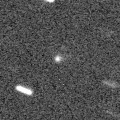
|
Now it is 17.3 mag (Jan. 15, ATLAS-HKO, Haleakala). It stays 17 mag for a while. It will be unobservable in May.
Date(TT) R.A. (2000) Decl. Delta r Elong. m1 Best Time(A, h)
Jan. 27 1 42.05 2 28.7 2.516 2.512 78 17.2 18:50 ( 38, 51)
Feb. 3 1 49.03 3 31.7 2.569 2.475 73 17.2 18:56 ( 48, 49)
|
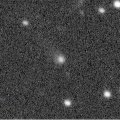
|
Now it is 16.9 mag (Jan. 3, W68 ATLAS Chile). It stays 18 mag for a while. In the Northern Hemisphere, it will never be observable after this. In the Southern Hemisphere, it stays observable in good condition.
Date(TT) R.A. (2000) Decl. Delta r Elong. m1 Best Time(A, h)
Jan. 27 6 32.15 -72 44.9 3.791 3.854 86 17.2 22:03 ( 0,-18)
Feb. 3 5 59.56 -72 22.9 3.818 3.872 85 17.3 21:04 ( 0,-17)
|
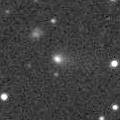
|
Now it is 16.6 mag (Jan. 4, Ken-ichi Kadota). Fading slowly. It will be fainter than 18 mag in March. In the Northern Hemisphere, it stays observable in good condition. In the Southern Hemisphere, it will be getting lower gradually.
Date(TT) R.A. (2000) Decl. Delta r Elong. m1 Best Time(A, h)
Jan. 27 3 21.63 7 1.0 2.921 3.291 103 17.3 18:58 ( 0, 62)
Feb. 3 3 24.91 7 40.1 3.033 3.308 97 17.4 18:56 ( 12, 62)
|

|
Now it is 17.3 mag (Jan. 13, Hidenori Nohara). It stays 18 mag for a while. It stays observable in good condition.
Date(TT) R.A. (2000) Decl. Delta r Elong. m1 Best Time(A, h)
Jan. 27 6 53.01 17 25.6 1.541 2.473 155 17.3 22:28 ( 0, 72)
Feb. 3 6 49.23 18 18.1 1.570 2.462 148 17.3 21:57 ( 0, 73)
|
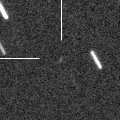
|
Now it is 17.2 mag (Jan. 24, ATLAS Chile). Fading gradually. It will be fainter than 18 mag in March. It locates somewhat low in the Northern Hemisphere. In the Southern Hemisphere, it stays observable in good condition.
Date(TT) R.A. (2000) Decl. Delta r Elong. m1 Best Time(A, h)
Jan. 27 10 3.67 -30 45.8 1.567 2.289 126 17.3 1:44 ( 0, 24)
Feb. 3 9 35.27 -33 25.9 1.573 2.325 129 17.4 0:48 ( 0, 22)
|
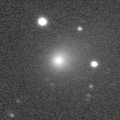
|
It continued brightening even after the perihelion passage, and it brightened up to 13.1 mag in autumn (Sept. 12, Taras Prystavski). Now it is 16.3 mag (Jan. 6, Yukihiro Sugiyama). It will fade out rapidly after this. It will be fainter than 18 mag in February. It locates somewhat low in the Northern Hemisphere. It stays extremely low in the Southern Hemisphere.
Date(TT) R.A. (2000) Decl. Delta r Elong. m1 Best Time(A, h)
Jan. 27 0 24.30 -9 6.9 4.246 3.791 56 17.4 18:50 ( 51, 31)
Feb. 3 0 31.13 -7 57.3 4.372 3.836 51 17.6 18:56 ( 57, 27)
|

|
It approached to Earth down to 0.29 a.u. in early last February, and it brightened up to 4.5 mag (Feb. 1, Juan Jose Gonzalez). Now it is 19.2 mag (Jan. 12, ATLAS South Africa). Fading slowly. It will be fainter than 18 mag in March. In the Northern Hemisphere, it will never be observable after this. In the Southern Hemisphere, it stays observable in good condition.
Date(TT) R.A. (2000) Decl. Delta r Elong. m1 Best Time(A, h)
Jan. 27 3 5.65 -56 50.3 4.992 4.893 78 17.4 18:50 ( 1, -2)
Feb. 3 3 2.43 -55 38.9 5.105 4.961 76 17.5 18:56 ( 6, -1)
|

|
Now it is 16.9 mag (Jan. 11, Toshihiko Ikemura, Hirohisa Sato). It stays 17 mag for a while. It stays observable in good condition.
Date(TT) R.A. (2000) Decl. Delta r Elong. m1 Best Time(A, h)
Jan. 27 7 58.70 -9 31.0 3.912 4.793 150 17.5 23:34 ( 0, 45)
Feb. 3 7 55.18 -9 32.2 3.883 4.753 148 17.4 23:03 ( 0, 45)
|
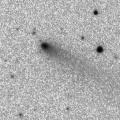
|
Now it is 16.9 mag (Jan. 21, ATLAS-MLO, Mauna Loa). It stays 18 mag for a while. In the Northern Hemisphere, it will be getting lower gradually. In the Southern Hemisphere, it will be unobservable in March. It is brighter than this ephemeris recently.
Date(TT) R.A. (2000) Decl. Delta r Elong. m1 Best Time(A, h)
Jan. 27 0 33.01 -1 56.3 4.331 3.945 60 17.4 18:50 ( 54, 38)
Feb. 3 0 38.73 -1 6.9 4.437 3.960 55 17.5 18:56 ( 61, 33)
|

|
It brightened up to 14.1 mag in 2022 spring (Mar. 22, 2022, Chris Wyatt). Now it is 17.0 mag (Jan. 7, ATLAS-HKO, Haleakala). It stays 18 mag for a while. It will be unobservable in March.
Date(TT) R.A. (2000) Decl. Delta r Elong. m1 Best Time(A, h)
Jan. 27 1 16.25 2 49.8 6.347 6.124 72 17.4 18:50 ( 47, 48)
Feb. 3 1 16.83 3 26.3 6.510 6.172 65 17.5 18:56 ( 57, 43)
|

|
Now it is 17.3 mag (Jan. 22, ATLAS-HKO, Haleakala). Fading gradually. It will be fainter than 18 mag in February. In the Northern Hemisphere, it stays observable in good condition. In the Southern Hemisphere, it will never be observable after this.
Date(TT) R.A. (2000) Decl. Delta r Elong. m1 Best Time(A, h)
Jan. 27 2 35.66 71 59.3 1.510 2.040 107 17.5 18:50 (176, 53)
Feb. 3 3 18.63 69 8.3 1.542 2.060 107 17.6 18:56 (176, 56)
|
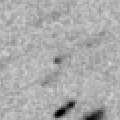
|
Now it is 17.4 mag (Jan. 10, ATLAS Chile). Fading gradually. It will be fainter than 18 mag in March. It stays observable in good condition.
Date(TT) R.A. (2000) Decl. Delta r Elong. m1 Best Time(A, h)
Jan. 27 12 14.58 3 37.8 1.418 2.133 124 17.6 3:53 ( 0, 59)
Feb. 3 12 16.26 3 0.1 1.361 2.138 130 17.5 3:27 ( 0, 58)
|
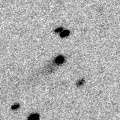
|
Now it is 17.3 mag (Jan. 20, ATLAS-HKO, Haleakala). It stays 18 mag for a while. It stays observable in good condition.
Date(TT) R.A. (2000) Decl. Delta r Elong. m1 Best Time(A, h)
Jan. 27 12 23.60 16 8.2 8.788 9.393 125 17.5 4:02 ( 0, 71)
Feb. 3 12 20.61 16 41.5 8.709 9.407 132 17.5 3:32 ( 0, 72)
|

|
Now it is 17.7 mag (Jan. 9, Toshihiko Ikemura, Hirohisa Sato). It stays 18 mag for a while. It locates somewhat low in the Northern Hemisphere. But it will become high in spring. In the Southern Hemisphere, it is not observable now, but it will appear in April.
Date(TT) R.A. (2000) Decl. Delta r Elong. m1 Best Time(A, h)
Jan. 27 22 34.46 37 56.9 4.581 4.231 63 17.6 18:50 (115, 35)
Feb. 3 22 35.80 37 28.7 4.655 4.225 58 17.6 18:56 (118, 29)
|

|
Now it is 17.7 mag (Jan. 11, Ken-ichi Kadota). It stays 17 mag for a while. It locates somewhat low in the Northern Hemisphere. In the Southern Hemisphere, it stays observable in good condition.
Date(TT) R.A. (2000) Decl. Delta r Elong. m1 Best Time(A, h)
Jan. 27 15 18.97 -26 43.6 3.356 3.193 72 17.7 5:35 (340, 25)
Feb. 3 15 26.90 -27 17.2 3.257 3.187 77 17.6 5:31 (344, 26)
|
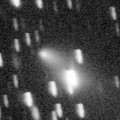
|
It brightened up to 13.6 mag in summer (July 16, Mitsunori Tsumura). Now it is 17.1 mag (Jan. 10, Thomas Lehmann). Fading gradually. It will be fainter than 18 mag in February. In the Northern Hemisphere, it stays observable in good condition. In the Southern Hemisphere, it will never be observable after this.
Date(TT) R.A. (2000) Decl. Delta r Elong. m1 Best Time(A, h)
Jan. 27 0 40.95 62 57.0 2.440 2.705 94 17.6 18:50 (152, 54)
Feb. 3 0 58.31 62 52.1 2.540 2.754 91 17.8 18:56 (150, 52)
|

|
Now it is 17.6 mag (Jan. 15, ATLAS-HKO, Haleakala). It stays 17 mag for a while. It stays observable in good condition.
Date(TT) R.A. (2000) Decl. Delta r Elong. m1 Best Time(A, h)
Jan. 27 11 1.79 1 21.2 5.212 5.998 139 17.8 2:41 ( 0, 56)
Feb. 3 10 58.45 2 20.4 5.102 5.962 148 17.7 2:10 ( 0, 57)
|
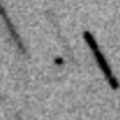
|
Now it is 18.0 mag (Jan. 14, Toshihiko Ikemura, Hirohisa Sato). Brightening gradually. In the Northern Hemisphere, it will be getting lower gradually after this, and it will be unobservable in April. In the Southern Hemisphere, it will be getting lower gradually. It will brighten up to 11 mag in summer. But it is not observable at the high light.
Date(TT) R.A. (2000) Decl. Delta r Elong. m1 Best Time(A, h)
Jan. 27 2 12.62 -8 28.7 3.062 3.086 82 17.8 18:50 ( 21, 44)
Feb. 3 2 15.06 -7 54.9 3.081 3.004 76 17.7 18:56 ( 31, 42)
|
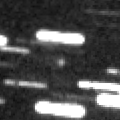
|
Now it is 18.6 mag (Jan. 11, Yasukazu Ikari). It stays 18 mag for a while. It stays observable in good condition.
Date(TT) R.A. (2000) Decl. Delta r Elong. m1 Best Time(A, h)
Jan. 27 6 32.52 9 12.1 6.907 7.768 149 17.7 22:08 ( 0, 64)
Feb. 3 6 27.11 9 15.1 6.976 7.770 141 17.7 21:35 ( 0, 64)
|

|
Now it is 17.8 mag (Jan. 19, ATLAS Chile). It stays 18 mag for a while. In the Northern Hemisphere, it is not observable now, but it will appear in March. In the Southern Hemisphere, it stays observable in good condition. It stays 15 mag for a long time from late 2024 to early 2026.
Date(TT) R.A. (2000) Decl. Delta r Elong. m1 Best Time(A, h)
Jan. 27 6 30.77 -63 3.8 5.569 5.734 94 17.8 22:05 ( 0, -8)
Feb. 3 6 22.66 -61 51.2 5.520 5.694 95 17.8 21:29 ( 0, -7)
|
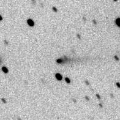
|
Now it is 17.2 mag (Jan. 19, ATLAS-HKO, Haleakala). Fading slowly. It will be fainter than 18 mag in February. It stays observable in good condition.
Date(TT) R.A. (2000) Decl. Delta r Elong. m1 Best Time(A, h)
Jan. 27 8 34.47 -3 53.1 3.157 4.083 157 17.8 0:14 ( 0, 51)
Feb. 3 8 30.37 -3 24.5 3.166 4.098 158 17.8 23:38 ( 0, 52)
|
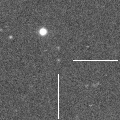
|
Far asteroid moving along a cometary orbit. It brightens up to 18 mag from 2024 to 2025. It stays 18 mag for a while. In the Northern Hemisphere, it stays observable in good condition. It stays extremely low in the Southern Hemisphere.
Date(TT) R.A. (2000) Decl. Delta r Elong. m1 Best Time(A, h)
Jan. 27 8 30.81 50 58.4 7.934 8.782 147 17.8 0:11 (180, 74)
Feb. 3 8 23.25 50 53.1 7.953 8.778 145 17.9 23:31 (180, 74)
|
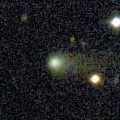
|
It brightened up to 13.9 mag in early 2023 (Jan. 21, Hidenori Nohara). Now it is 19.1 mag (Jan. 11, Toshihiko Ikemura, Hirohisa Sato). It stays 18 mag for a while. It stays observable in good condition.
Date(TT) R.A. (2000) Decl. Delta r Elong. m1 Best Time(A, h)
Jan. 27 14 37.04 6 52.5 4.511 4.643 91 17.9 5:35 (340, 60)
Feb. 3 14 40.03 7 10.2 4.452 4.685 97 17.9 5:31 (350, 62)
|
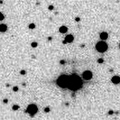
|
Now it is 18.9 mag (Jan. 13, ATLAS-MLO, Mauna Loa). It stays 18 mag for a while. It stays observable in good condition.
Date(TT) R.A. (2000) Decl. Delta r Elong. m1 Best Time(A, h)
Jan. 27 10 9.59 12 52.8 3.325 4.245 156 17.9 1:49 ( 0, 68)
Feb. 3 10 5.95 13 11.3 3.297 4.254 164 17.9 1:17 ( 0, 68)
|
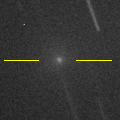
|
It brightened up to 14.7 mag at the discovery in December (Dec. 6, Hidetaka Sato). Now it is 17.3 mag (Jan. 11, Ken-ichi Kadota). Fading rapidly. In the Northern Hemisphere, it stays observable in good condition. In the Southern Hemisphere, it is not observable now.
Date(TT) R.A. (2000) Decl. Delta r Elong. m1 Best Time(A, h)
Jan. 27 19 20.07 81 51.8 1.439 1.892 100 17.9 5:35 (190, 36)
Feb. 3 21 37.72 80 52.7 1.588 1.979 97 18.5 18:56 (169, 34)
|
|
![]()
 C/2022 L2 ( ATLAS )
C/2022 L2 ( ATLAS ) 29P/Schwassmann-Wachmann 1
29P/Schwassmann-Wachmann 1 207P/NEAT
207P/NEAT C/2019 U5 ( PanSTARRS )
C/2019 U5 ( PanSTARRS ) P/2023 W1 ( NEAT )
P/2023 W1 ( NEAT ) C/2021 T4 ( Lemmon )
C/2021 T4 ( Lemmon ) C/2021 G2 ( ATLAS )
C/2021 G2 ( ATLAS ) C/2019 L3 ( ATLAS )
C/2019 L3 ( ATLAS ) C/2023 H2 ( Lemmon )
C/2023 H2 ( Lemmon ) 13P/Olbers
13P/Olbers 32P/Comas Sola
32P/Comas Sola C/2020 K1 ( PanSTARRS )
C/2020 K1 ( PanSTARRS ) C/2023 P1 ( Nishimura )
C/2023 P1 ( Nishimura ) C/2019 T4 ( ATLAS )
C/2019 T4 ( ATLAS ) 226P/Pigott-LINEAR-Kowalski
226P/Pigott-LINEAR-Kowalski C/2022 QE78 ( ATLAS )
C/2022 QE78 ( ATLAS ) C/2014 UN271 ( Bernardinelli-Bernstein )
C/2014 UN271 ( Bernardinelli-Bernstein ) C/2023 C2 ( ATLAS )
C/2023 C2 ( ATLAS ) C/2022 S4 ( Lemmon )
C/2022 S4 ( Lemmon ) 65P/Gunn
65P/Gunn 150P/LONEOS
150P/LONEOS P/2011 NO1 ( Elenin )
P/2011 NO1 ( Elenin ) C/2021 Y1 ( ATLAS )
C/2021 Y1 ( ATLAS ) 471P/2023 KF3
471P/2023 KF3 C/2023 V4 ( Camarasa-Duszanowicz )
C/2023 V4 ( Camarasa-Duszanowicz ) 227P/Catalina-LINEAR
227P/Catalina-LINEAR C/2022 T1 ( Lemmon )
C/2022 T1 ( Lemmon ) C/2023 F3 ( ATLAS )
C/2023 F3 ( ATLAS ) C/2022 U3 ( Bok )
C/2022 U3 ( Bok ) C/2021 S4 ( Tsuchinshan )
C/2021 S4 ( Tsuchinshan ) C/2019 E3 ( ATLAS )
C/2019 E3 ( ATLAS ) 125P/Spacewatch
125P/Spacewatch C/2022 R6 ( PanSTARRS )
C/2022 R6 ( PanSTARRS ) C/2023 K1 ( ATLAS )
C/2023 K1 ( ATLAS ) 30P/Reinmuth 1
30P/Reinmuth 1 C/2022 A3 ( Lemmon-ATLAS )
C/2022 A3 ( Lemmon-ATLAS ) 170P/Christensen
170P/Christensen P/2023 Y3 ( ATLAS )
P/2023 Y3 ( ATLAS ) C/2022 V2 ( Lemmon )
C/2022 V2 ( Lemmon ) C/2022 JK5 ( PanSTARRS )
C/2022 JK5 ( PanSTARRS ) C/2022 E3 ( ZTF )
C/2022 E3 ( ZTF ) C/2023 T3 ( Fuls )
C/2023 T3 ( Fuls ) 117P/Helin-Roman-Alu 1
117P/Helin-Roman-Alu 1 C/2020 Y2 ( ATLAS )
C/2020 Y2 ( ATLAS ) C/2023 T2 ( Borisov )
C/2023 T2 ( Borisov ) 216P/LINEAR
216P/LINEAR C/2020 F2 ( ATLAS )
C/2020 F2 ( ATLAS ) C/2022 U1 ( Leonard )
C/2022 U1 ( Leonard ) 299P/Catalina-PanSTARRS
299P/Catalina-PanSTARRS 126P/IRAS
126P/IRAS C/2023 H5 ( Lemmon )
C/2023 H5 ( Lemmon ) C/2023 R2 ( PanSTARRS )
C/2023 R2 ( PanSTARRS ) C/2021 A9 ( PanSTARRS )
C/2021 A9 ( PanSTARRS ) C/2024 A1 ( ATLAS )
C/2024 A1 ( ATLAS ) 408P/2020 M7 ( Novichonok-Gerke )
408P/2020 M7 ( Novichonok-Gerke ) (468861) 2013 LU28
(468861) 2013 LU28 C/2020 S4 ( PanSTARRS )
C/2020 S4 ( PanSTARRS ) 244P/Scotti
244P/Scotti C/2023 X1 ( Leonard )
C/2023 X1 ( Leonard )![]()
































































